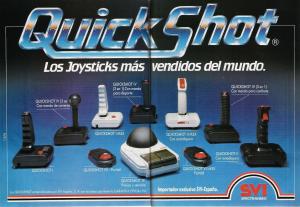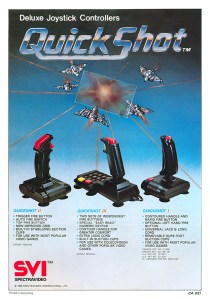Exhibit / May 16, 2017
Object Name: Quickshot Joysticks
Maker and Year: Spectravision, 1982-1988
Object Type: Joysticks
Image Source: vgpavilion, cpcrulez, oldcomputr
Description: (Richard McKenna)
As sophisticated new electronic entertainments entered the lives of increasing numbers of people during the 1980s, sophisticated new interfaces were designed to utilize these entertainments—and capitalize on them—to their fullest potential. The joystick was invented originally to satisfy the need to control movement in three dimensions following the invention of the aircraft in the early 20th century, and the first known use of the word appears in a 1910 entry in the journal of successful British stage actor-turned-aeronautical-pioneer Robert Loraine. The word also carries sexual connotations, its first appearance in this context appearing in print in 1916. Whatever its true origin, the joystick proved perfectly suited to controlling the video games that, from the 1970s on, began to dominate the leisure time and imaginations of many.
Despite more aesthetically-developed exceptions like those that came with Atari’s VCS home video console, the joystick’s form was generally functional and uninspiring—a slim shaft with a round head connected to a box that was anchored in the player’s non-playing hand. The home computer boom of the early 1980s, however, opened up a landscape of opportunity for third-party hardware manufacturers. In 1982, American computer and video games company Spectravision (founded in 1981 by two Swiss watchmakers, Harry Fox and Oscar Jutzeler) released the Quickshot I, the first attempt at an ergonomic video game joystick. Developed and patented by Fox and Peter Law of Bondwell computers, the Quickshot I was equipped with dual firing buttons—one on the base and one on the joystick itself—and four suction cups, which allowed it to be attached to tabletops, theoretically freeing the player’s “game” hand and combining the functional allure of military hardware with the visionary gleam of arcade aesthetics. Despite the relative simplicity of its engineering, the Quickshot I proved to be enormously successful, and increasingly complex Quickshot models soon followed, eventually reaching Quickshot IX before Spectravision ceased trading in 1988.
Harry Fox continued to work in computers until his retirement in 2001, while Jutzeler returned to his original trade, working in his shop The Clock Factory until his death in 2011.






Nice! I actually have a Quickshot 1, yet I’m not sure exactly how I came into possession of it. I believe it came bundled with a used lot of Atari hardware and cartridges I bought some years back during my whole “Atari Acquisition” phase. It is actually a nice joystick and much more ergonomic than the Atari standard sticks. The option between the two fire buttons is also a huge plus. It definitely brings the arcade aspect home.
Those suction cups, btw, are no joke. You stick that thing down on a glass table and it ain’t going nowhere.
I was pretty hooked on that Quickshot, until I found a pair of Wico Command Control joysticks (bat handle), which, among my nerdy circle of friends back in the early ’80s, were the supreme-dupreme of the joystick universe (and expensive as all hell). Those have since been permanently connected to my Atari 2600/VCS.
On a related note, I totally remember a time (’82-’84?) when computer electronics/video game sections at various retail stores would have a whole array of joysticks on display, each one velcro’d or bolted onto a metal shelf for customers to grasp and get a feel for. There really were tons to choose from.
The SpaceTaxi Vintage Joystick Museum has a pretty impressive collection which brings it all back…
http://members.optusnet.com.au/spacetaxi64/MAIN/JOYSTICK-MUSEUM.htm